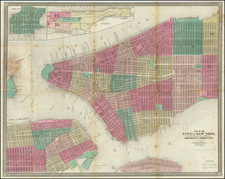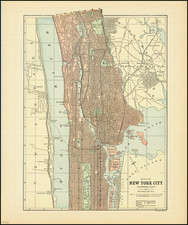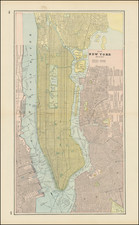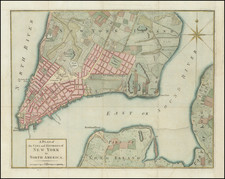A Hudson River Bridge To Dwarf the Woolworth Building
Previousl unrecorded separately published map of New York City and environs, published for the North River Bridge Company.
The North River Bridge Company proposed in the late 1880s the construction of a mammoth bridge across the Hudson River. The proposed bridge, which received congressional approval in July 1890, was to be 200 feet wide and 200 feet high to accommodate 12 railroads, 24 traffic lanes and 2 pedestrian walks. The bridge would have been double the length of the George Washington Bridge,with twin 825-foot-high towers, which would have made them taller than the 792-foot Woolworth Building (which at the time was taller than the world’s tallest skyscraper at the time).
The map provides a remarkably detailed image of New York City, with special empahsis on the North River Bridge project and the various tranit routes and stations associated therewith, including:
- North River Bridge Co. Viaduct
- Meadow Station
- Palisades Station
- King Street Station and connecting line
- Hoboken Station and Anchorage for the Bridge
- Anchorage on the east side of the bridge
- High Level Union Passenger Station
- Proposed 42nd Street Tunnel Project
The map illustrates the early projections for the Hudson River Bridge. Ground was broken for the bridge on June 8, 1895, and the first foundation masonry was laid at the site of the Hoboken anchorage, across the Hudson River from West 23rd Street in Manhattan. Work did not progress much further because of the difficulties in financing the $37 million cost of the project.
A Bridge Across The Hudson River
The following is excerpted from Lindenthal and his pursuit of a bridge across the Hudson River, by K. Ghandi.
The oldest written reference to bridging the Hudson River at NewYork is in the book “A Treatise on Bridge Architecture” by Thomas Pope, published in 1811. . . . Another scheme was proposed by Messrs. Anderson and Barr in 1884 which required placing piers in water to provide a clear span of 500 ft. (152.4 m) for navigation (Engineering News 1884a).
At a meeting of the American Society of Civil Engineers held in Kaeterskill, NY on January 4, 1888 Gustav Lindenthal read the paper “The North River Bridge Problem, with a Discussion on Long Span Bridges” (Engineering News 1888a). This was the first time that someone had seriously thought about building a bridge across the Hudson River. . . . The editorial in Engineering News stated that this is “the first definite description of a work which has at least a very fair chance of becoming the greatest of its kind on this continent, or in the world” (Engineering News 1888c). . . .
After the publication of his paper, Lindenthal patented details of sheet metal cable cover to protect the cable from weather and changes of temperature; and the method of making attachments to the cable and of joining the cable itself in sections (Engineering Record 1888). . . .
In the late 1880s the Pennsylvania Railroad (PennRR) wanted a direct rail entrance into New York City, and Lindenthal was retained by Mr. Samuel Rae of the PennRR to study the feasibility of such a move. The original scheme was to enter Lower Manhattan with a terminal at Washington Square. However, the cost seemed prohibitive for the PennRR to bear it alone. Lindenthal was asked by the PennRR to find out if other railroads would participate in building the bridge across the Hudson and sharing the cost of construction.
The result was the formation in 1890 of a Corporation called the North River Bridge Co., and the incorporators included Jordan L. Mott, Jr., King McLanahan, James Andrews, Thomas F. Ryan, Garrett A. Hobart, F.W. Roebling, Charles J. Canda, Edward F.C.Young, Henry Flad, Gustav Lindenthal, A.G. Dickinson, John H. Miller, William Brookfield, Samuel Rea, William F. Shunk, Philip E. Chapin, and their associates (Engineering News 1890b).
The supporters . . . introduced bills in July 1888 in both houses of Congress to build a bridge with a single span of 2,830 ft. (862.6 m). . . . [with modifications suggested by the War Department,] the North River Bridge Bill was passed by both Houses of Congress by June 1890. . . .
The bridge had two levels with a capacity of 14 standard gage railway tracks. The limits of the bridge were between Bloomfield and Twelfth Streets in Hoboken, and 23rd Street and Tenth Avenue in New York. From this point in New York, a steel viaduct would carry the 14 tracks to a high level station on Sixth Avenue, extending from 25th to 28th Streets with a connection with the yards of the New York Central on 39th Street. The estimated total cost was $70,000,000 (Engineering News 1891b).
In March 1892, the North River Bridge Co. commenced proceedings to condemn property which was within its right-of-way under its charter from the Congress, [which resulted in a court battle which would reach the Supreme Court]. . . . The lawsuit was decided in favor of the North River Bridge Co., but the business depression of 1893 forced indefinite postponement of the Hudson River Bridge project . . .
The recession of 1893 forced almost all railroads to withdraw their support of the Hudson River Bridge project. The railroads were not willing to discuss their plans for expansion to New York with other railroads and the Hudson River Bridge project was practically abandoned by the railroads who would provide the funding for the bridge. The promoters were telling the public that traffic that would make the bridge pay could be secured from the beginning.
The charter of the North River Bridge Co. was to expire on July 11, 1895 unless something was done by that time showing the sincere purpose of the North River Bridge Co. to construct the work for which it obtained the powers. It was to show this intention and prevent the charter from lapsing that the North River Bridge Co. quietly commenced work upon the New Jersey anchorage. . . .
In 1897, the promoters of the North River Bridge Co. refused to provide any information on their plans for the bridge. However, it was known that the length of the suspension span and the total length of the bridge proper would be 3,100 ft. (944.9 m) and 7,340 ft. (2,237.2 m), respectively. No definite traffic arrangements were made with any of the railway companies operating on the New Jersey side. The railway companies did not show their willingness to cooperate with each other in the discussion of construction of the necessary connections and terminals. Without the support from the railroads the bridge project was dead (Engineering News 1897).
. . . In 1900, the U.S. Senate passed Senator Sewell’s bill extending the time for completion of Lindenthal’s bridge to January 1, 1902 (Railroad Gazette, 1900). In 1901, the North River Bridge Co. entered into discussions with two or three railroads to back its plan without any success (Railroad Gazette 1901). . . .
The biggest setback to the Hudson River Bridge project came when the PennRR in 1904 decided to go it alone and build two tunnels under the Hudson, a major passenger terminal in Manhattan near 34th Street, and a yard for its trains in Queens by building tunnels under the East River. There were no major activities from 1905 to 1911. [While efforts to complete the Bridge continued until the early 1930s, no further progress was made toward its completion.]
Rarity
OCLC locates a single example in the Hagley Museum & Library ("In : Pennsylvania Railroad Company records").
Provenance
The present example was acquired as part of an otherwise unrelated group blueprints and related material from the Société des Établissements Eiffel (Alexandre-Gustave Eiffel's engineering company), sold at Oger-Blanchet October 26, 2018, Lot #56.









![Vereinigte Staaten von Nord-Amerika [Views of New York City and Back Country Scenes]](https://storage.googleapis.com/raremaps/img/small/25442.jpg)


![Map of the State of New York with Part of Upper Canada [Large inset plan of New York]](https://storage.googleapis.com/raremaps/img/small/91848.jpg)

